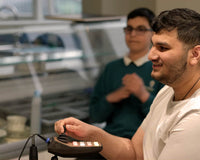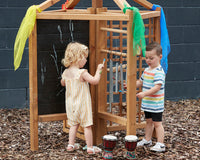Bassoons
 Bassoons are known for playing music written in the bass and tenor clefs. The Bassoon forms part of the double reed family. It's often seen in the middle of an Orchestra or Concert Band. This instrument is most commonly made of maple or plastic for beginners. With medium-hardness types such as sycamore maple and sugar maple available, these are more suitable for those with more experience. This Bassoon disassembles into 6 main features:
Bassoons are known for playing music written in the bass and tenor clefs. The Bassoon forms part of the double reed family. It's often seen in the middle of an Orchestra or Concert Band. This instrument is most commonly made of maple or plastic for beginners. With medium-hardness types such as sycamore maple and sugar maple available, these are more suitable for those with more experience. This Bassoon disassembles into 6 main features:
- The Bell
- The Bass Joint (or long Joint)- extends upwards
- The Boot (or Butt)- Bass Joint connects The Bell and The Boot
- Wing Joint- at the bottom of the instrument
- The Bocal (or Crook)- Wing Joint extends from Boot to Bocal
- A Crooked metal tube- attaches the Wing Joint to a reed
Clarinets
A Clarinets  The A Clarinet is better suited for the advanced and professional players, as it is known to be more complicated to play. It's known to be different to the Bb Clarinet in the way it sounds and the way you play. Some may struggle if you are playing between the A Clarient and the Bb Clarinet but with practice this problem should be resolved.
The A Clarinet is better suited for the advanced and professional players, as it is known to be more complicated to play. It's known to be different to the Bb Clarinet in the way it sounds and the way you play. Some may struggle if you are playing between the A Clarient and the Bb Clarinet but with practice this problem should be resolved.
Bb Clarinets  This is the most popular and frequently used clarinet and is the most common type of soprano clarinet. It's popular amongst the younger generation and for beginners. It is used in the Wind Orchestra and for Jazz and Classical music; it produces beautiful harmonies with a unique tone and rang.
This is the most popular and frequently used clarinet and is the most common type of soprano clarinet. It's popular amongst the younger generation and for beginners. It is used in the Wind Orchestra and for Jazz and Classical music; it produces beautiful harmonies with a unique tone and rang.
Harmony Clarinets  These include the Bass Clarinet, Plastic Clarinet and other Harmony Clarinets. The Plastic Clarinets are ideal for children and are easier to hold which is ideal for those smaller hands.
These include the Bass Clarinet, Plastic Clarinet and other Harmony Clarinets. The Plastic Clarinets are ideal for children and are easier to hold which is ideal for those smaller hands.
Bass
Bass clarinet is usually pitched in Bb and regularly performs in orchestras, wind ensembles and concert bands. It's one of the larger clarinets and is quite heavy; for some too heavy to hold in your hand so a carrying strap is often required.
Flutes
 The Flute is a reedless wind instrument and produces its sound through the flow of air across an opening. Flutes are the earliest known instrument and were originally made from wood, stone and clay. They are commonly made of silver, gold or platinum. The flute is available for all levels and abilities. The Flute is played by holding in sideways with both hands and blowing across the mouthpiece hole. The player uses their fingers to change the pitch by opening and closing the holes.
The Flute is a reedless wind instrument and produces its sound through the flow of air across an opening. Flutes are the earliest known instrument and were originally made from wood, stone and clay. They are commonly made of silver, gold or platinum. The flute is available for all levels and abilities. The Flute is played by holding in sideways with both hands and blowing across the mouthpiece hole. The player uses their fingers to change the pitch by opening and closing the holes.
Piccolos and Harmony Flutes  The Piccolo is half the size of a Flute and is more suitable for children due to its size. It is played the same as the flute with most of the same fingerings however the sound produced is an octave higher. Piccolos actually play the highest notes out of all the woodwind instruments. Piccolos often play with the violins or the Flutes when playing together in an Orchestra.
The Piccolo is half the size of a Flute and is more suitable for children due to its size. It is played the same as the flute with most of the same fingerings however the sound produced is an octave higher. Piccolos actually play the highest notes out of all the woodwind instruments. Piccolos often play with the violins or the Flutes when playing together in an Orchestra.
Oboes and Cor Anglais
The Oboe is a double reed woodwind instrument and plays in the Treble and Soprano range. A sound is produced by blowing into the reed and vibrating a column of air. The tone of the Oboe has been described as "bright".
The Cor Anglais is part of the Oboe family and is also a double-reed woodwind instrument. It's one and a half times the length of the Oboe and is pitched in F, a fifth lower than the Oboe. This instrument is played the same as the Oboe.
Recorders
 It is often used for solo music. This instrument has 7 holes where your fingers can be placed when you play. When you blow you make different notes based on what holes your fingers are covering. Recorders are most often tuned in C or F, with their lowest note being a C or an F. This instrument is a great one for children and commonly used in Primary schools as they are usually plastic and can be cheaply sourced. Recorders can be made out of different materials including Wood, Plastic or Ivory. It is very durable and won't break the bank.
It is often used for solo music. This instrument has 7 holes where your fingers can be placed when you play. When you blow you make different notes based on what holes your fingers are covering. Recorders are most often tuned in C or F, with their lowest note being a C or an F. This instrument is a great one for children and commonly used in Primary schools as they are usually plastic and can be cheaply sourced. Recorders can be made out of different materials including Wood, Plastic or Ivory. It is very durable and won't break the bank.
Saxophones
Alto Saxophone  This Saxophone is most commonly known and used and is perfect for beginners. It is pitched in Eb; this instrument is used by most classical and jazz players. Famous players include John Coltrane and Bill Clinton, those names you may recognise. This Sax is in the middle of the Tenor and Soprano. It's smaller than the Tenor but larger than the Soprano.
This Saxophone is most commonly known and used and is perfect for beginners. It is pitched in Eb; this instrument is used by most classical and jazz players. Famous players include John Coltrane and Bill Clinton, those names you may recognise. This Sax is in the middle of the Tenor and Soprano. It's smaller than the Tenor but larger than the Soprano.
Baritone Saxophones  This is the largest type of saxophone and pitched an octave below the alto saxophone; they are pitched at Eb. It uses a single reed like a Clarinet would. Some may not know that it's the lowest-pitched saxophone and uses a larger mouthpiece, reed and ligature; all bigger than the Alto, Soprano and Tenor Saxophone. Due to it being one of the bigger types of Saxophones it is more commonly damaged due to its size. This type of Saxophone is commonly used in classical music. Such as marching bands, Military bands, Concert bands and Jazz.
This is the largest type of saxophone and pitched an octave below the alto saxophone; they are pitched at Eb. It uses a single reed like a Clarinet would. Some may not know that it's the lowest-pitched saxophone and uses a larger mouthpiece, reed and ligature; all bigger than the Alto, Soprano and Tenor Saxophone. Due to it being one of the bigger types of Saxophones it is more commonly damaged due to its size. This type of Saxophone is commonly used in classical music. Such as marching bands, Military bands, Concert bands and Jazz.
Soprano Saxophones  Pitched in Bb this is one of the highest pitched Saxophones. This is an octave above the Tenor Saxophone. Players of the Soprano Saxophone are able to personalise their playing tone, as mouthpieces are available in different designs varying the tone when played. Mainly used for solo performances and in classical music. Although sometimes seen in a Concert band or Orchestra as well.
Pitched in Bb this is one of the highest pitched Saxophones. This is an octave above the Tenor Saxophone. Players of the Soprano Saxophone are able to personalise their playing tone, as mouthpieces are available in different designs varying the tone when played. Mainly used for solo performances and in classical music. Although sometimes seen in a Concert band or Orchestra as well.
Tenor Saxophones  Larger than the Alto Saxophone and pitched in the key Bb, making it a lower sounding instrument. It's one of the more common saxophones to be played and is popular in Jazz bands; often sharing parts or harmonies with the Alto Saxophone. The Tenor often takes a back seat in concert bands sometimes sharing parts with the Horn and Trombone. The Tenor Saxophone uses a larger mouthpiece, reed and ligature than the other Saxophones.
Larger than the Alto Saxophone and pitched in the key Bb, making it a lower sounding instrument. It's one of the more common saxophones to be played and is popular in Jazz bands; often sharing parts or harmonies with the Alto Saxophone. The Tenor often takes a back seat in concert bands sometimes sharing parts with the Horn and Trombone. The Tenor Saxophone uses a larger mouthpiece, reed and ligature than the other Saxophones.
I hope you have found this useful and now have a better understanding of all the different instruments that are included in the woodwind family. If you have any questions please contact the sales team by phone: 01283 535333 or email: sales@normans.co.uk and they will be happy to help!





















